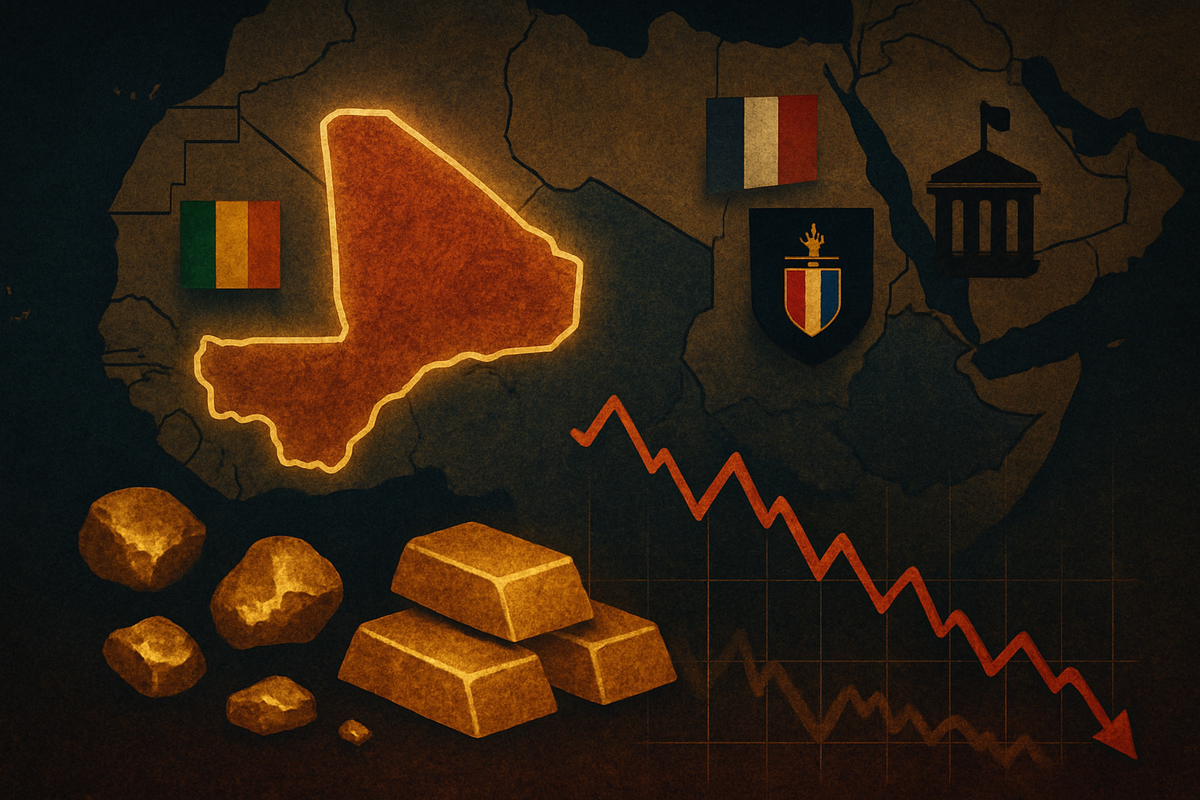
The global commodity markets are once again feeling the tremors of geopolitical instability, with the recent saga surrounding Barrick Gold Corporation's (NYSE: GOLD) operations in Mali serving as a stark illustration. What began as a dispute over a new mining code escalated into the provisional administration of one of Africa's largest gold mines, underscoring the immediate and profound implications of political shifts on critical resource supplies and prices. This incident not only sent ripples through the gold market but also cast a long shadow over the investment climate in resource-rich nations, particularly across the African continent, where resource nationalism is increasingly becoming a dominant theme.
The disruption to Barrick's Loulo-Gounkoto complex, a significant contributor to global gold output, highlights how swiftly political decisions can translate into supply chain disruptions and price volatility. As governments in key producing regions assert greater control over their natural resources, mining companies and investors face heightened risks, forcing a re-evaluation of operational strategies and geopolitical risk assessments in an already complex global economic landscape.
The Malian Gold Rush: A Timeline of Tensions
The dispute between Barrick Gold and Mali's military-led government is a complex tapestry woven from shifting political sands and economic imperatives. Mali, Africa's second-largest gold producer, relies heavily on gold exports, which account for a staggering 80% of its government revenue. Following a series of military coups in 2020 and 2021, the new Malian junta embarked on an ambitious overhaul of the nation's mining code, aiming to secure a larger share of the profits from its vast mineral wealth.
This revised framework, enacted between 2023 and 2025, significantly increased state ownership in mining projects from 20% to 35% and imposed higher taxes on foreign mining companies. The government justified these changes as essential for funding defense and development initiatives. Barrick Gold's Loulo-Gounkoto complex, a joint venture that typically produces around 700,000 ounces of gold annually and constitutes approximately 14% of Barrick's global production, became a focal point of these new policies. The mine alone contributed nearly 9.8% to Mali's GDP in 2023, making it a critical asset for both the company and the nation.
Tensions escalated dramatically in early 2025. Malian authorities accused Barrick of unpaid taxes and non-compliance with the new mining code. In a series of aggressive moves, Malian authorities detained Barrick employees and, critically, seized approximately 3 metric tons of gold, valued at around $245 million, halting all exports from the complex. This culminated in Barrick's temporary suspension of all operations at Loulo-Gounkoto in January 2025 due to the inability to ship gold. The situation reached a critical juncture in May 2025 when a Malian court placed the mine under provisional administration, effectively transferring operational control to a government appointee. By October 2025, operations had reportedly resumed under state management, albeit without Barrick's consent.
The immediate market reaction was one of considerable uncertainty. For Barrick Gold (NYSE: GOLD), the suspension and subsequent state takeover meant substantial operational disruption and the inability to fully capitalize on a significant rally in gold prices throughout 2025, leading to considerable opportunity costs for its shareholders. The company has since initiated international arbitration proceedings and filed appeals in Malian courts to challenge the detentions and the mine's administration. The disruption to such a major gold-producing asset injected significant supply uncertainty into the global gold market, contributing to price volatility during a period when gold prices were already hovering near record highs, further emphasizing the delicate balance between resource security and geopolitical stability.
Winners and Losers in the Geopolitical Tug-of-War
The Barrick Gold (NYSE: GOLD) situation in Mali presents a clear dichotomy of potential winners and losers, with implications extending far beyond the immediate protagonists.
On the losing side, Barrick Gold (NYSE: GOLD) itself faces significant financial and operational setbacks. The temporary cessation of operations, the seizure of gold, and the eventual loss of operational control at Loulo-Gounkoto have resulted in substantial lost production and revenue. The company has also incurred considerable legal costs as it pursues international arbitration and local court appeals. Furthermore, the inability to sell gold during a period of high prices represents a significant opportunity cost for shareholders. Beyond direct financial losses, Barrick's reputation and operational security in other developing nations could be impacted, potentially leading to higher political risk premiums for its future projects.
Other mining companies operating in regions with similar political instability or nascent resource nationalism movements are also indirect losers. The Malian precedent could embolden other governments to pursue more aggressive nationalization or renegotiation tactics. This translates into elevated political risk assessments, higher insurance costs, and potentially increased demands for local content or equity participation, making new investments less attractive and existing operations more precarious. Companies like B2Gold (TSX: BTO) and Endeavour Mining (TSX: EDV), which also have significant operations in West Africa, have already had to navigate revised mining codes and negotiate settlements with the Malian government, highlighting the changed operational environment and increased cost of doing business.
Conversely, the immediate "winner" appears to be the Malian government. By asserting greater control over the Loulo-Gounkoto complex, it aims to increase its share of gold revenues, which are crucial for its national budget and to fund its defense and development priorities. The move aligns with a broader trend of resource nationalism, where governments seek to maximize benefits from their natural resources. However, this short-term gain might come at the expense of long-term foreign direct investment, as the perceived increase in political risk could deter future capital inflows into Mali's mining sector.
Potential indirect "winners" could include gold producers in politically stable jurisdictions. As geopolitical risks escalate in traditional mining hubs, investors may reallocate capital to companies operating in countries with robust legal frameworks and predictable regulatory environments. This shift in investor preference could lead to higher valuations and easier access to capital for miners in regions like Canada, Australia, or parts of the United States. Additionally, the overall supply uncertainty created by events like the Malian disruption could contribute to higher gold prices globally, benefiting all producers, albeit with varying degrees of operational stability.
The Wider Significance: A Continental Shift Towards Resource Sovereignty
The Barrick Gold (NYSE: GOLD) debacle in Mali is not an isolated incident but rather a potent symbol of a broader, accelerating trend of resource nationalism sweeping across Africa and, indeed, the global mining landscape. This movement is characterized by governments asserting greater control over their natural resources, driven by a confluence of economic ambition, strategic imperatives, and a desire to rectify perceived historical imbalances in wealth distribution.
This event fits squarely into the burgeoning trend of increased state control over mineral wealth. Mali's revised 2023 mining law, which demands higher royalty fees and mandates a substantial 35% stake for Malian investors in new projects, mirrors legislative shifts observed in other African nations. As Africa holds a significant portion of the world's gold (40%) and critical minerals, governments are increasingly leveraging these strategically important resources to maximize national gains. This is often fueled by a belief that past agreements with foreign companies did not adequately benefit their countries, leading to a push for renegotiation and stricter terms. The political volatility prevalent in countries like Mali, Burkina Faso, and Niger, often under military governments, further amplifies this assertive stance on resource nationalism, adding another layer of uncertainty for investors.
The ripple effects of such interventions are far-reaching. The most immediate impact is a heightened perception of sovereign risk for foreign investors. Companies looking to invest in politically volatile jurisdictions will likely demand higher returns to offset concerns about potential nationalization, arbitrary policy changes, or contract renegotiations. This effectively increases the risk premium for projects in these regions, potentially rendering some ventures uneconomical and diverting capital towards more stable investment environments. Furthermore, companies with significant operations in countries exhibiting similar tendencies towards resource nationalism may see a reevaluation of their stock valuations, prompting a cautious re-evaluation of international mining investments.
Regulatory and policy implications are also profound. African governments are actively revising mining codes to secure greater benefits. Countries like Ghana, the Democratic Republic of Congo (DRC), and Zambia have introduced stricter regulations, often increasing state participation, royalty rates, and local ownership requirements. This pursuit of "economic sovereignty" often involves strategies like value addition, tax reforms, local content requirements, and profit-sharing mechanisms. The frequent changes in policy and tax systems, however, create an unpredictable environment, highlighting the delicate balance between national interests and a stable investment climate. The increasing number of disputes, evidenced by Barrick's initiation of arbitration proceedings, also suggests a surge in international legal battles between mining investors and African states.
Historically, resource nationalism is a cyclical phenomenon. The mid-20th century saw widespread nationalization across newly independent African states. More recently, the oil and gas sector has a long history of nationalization and contract renegotiation. In the mining sector, similar disputes have arisen. Notably, in 2017, Tanzania imposed a massive fine on Barrick Gold's subsidiary, Acacia Mining, alleging tax evasion, ultimately leading to a renegotiated agreement and increased state benefits. The DRC's 2018 mining code revision led to prolonged disputes with major players like Glencore (LSE: GLEN) and China Molybdenum (HKG: 3993), especially pertinent given the DRC's vast cobalt reserves. Zambia has also seen increased resource nationalism, including an attempted liquidation of Konkola Copper Mines (KCM). These precedents underscore that governments' desire to secure greater control and economic benefits from their natural resources is a consistent driver, often intensifying during commodity price booms.
What Comes Next: Navigating a Shifting Landscape
The immediate aftermath of the Barrick Gold (NYSE: GOLD) situation in Mali will likely be dominated by legal and diplomatic maneuvers. Barrick's pursuit of international arbitration through the International Center for the Settlement of Investment Disputes (ICSID) signals a long and potentially complex legal battle, the outcome of which could set precedents for future disputes between foreign investors and host governments in Africa. In the short term, as of October 2025, the Malian government appears to be consolidating control over the Loulo-Gounkoto complex, aiming to maximize its revenue streams. However, the long-term sustainability of operations under state management, particularly concerning technical expertise, capital investment, and market access, remains to be seen.
For Barrick, strategic pivots are inevitable. The company will likely intensify its efforts to diversify its geographical risk exposure, potentially prioritizing investments in more politically stable jurisdictions. This could involve increasing exploration and development activities in regions like North America or Australia, or re-evaluating its portfolio to reduce reliance on countries with high geopolitical risk. Furthermore, mining companies across the board will need to adopt more proactive and sophisticated engagement strategies with host governments, focusing on transparent operations, robust local content development, and demonstrable contributions to national development to mitigate future conflicts.
The gold market itself faces a period of continued scrutiny regarding supply security. While Barrick's Loulo-Gounkoto complex is a significant producer, the overall impact on global gold prices will depend on the duration of the disruption and whether similar events occur elsewhere. However, the incident reinforces gold's role as a safe-haven asset, potentially contributing to sustained high prices as investors seek refuge from geopolitical uncertainties. This creates opportunities for gold producers in stable regions, who may see increased investor interest and premium valuations. Conversely, the challenge for the broader industry lies in balancing the allure of rich mineral deposits in developing nations with the escalating political risks.
Potential scenarios and outcomes are varied. A resolution through arbitration could see Barrick regain some form of control or receive compensation, though the exact terms would be subject to negotiation. Alternatively, the Malian government could maintain full control, potentially seeking new operational partners, possibly from non-Western nations. The broader implication is that resource-rich developing nations may increasingly forge new alliances, potentially shifting away from traditional Western mining partners towards countries like China or Russia, which may offer different investment terms and exhibit less concern over governance issues. This could lead to a fragmentation of the global mining investment landscape and altered supply chain dynamics for critical minerals.
Comprehensive Wrap-up: Navigating a Volatile Future
The Barrick Gold (NYSE: GOLD) saga in Mali serves as a powerful and timely reminder of the volatile interplay between geopolitical forces, resource nationalism, and global commodity markets. The key takeaway for the mining sector is the undeniable acceleration of resource nationalism, characterized by increasing demands from host governments for greater control, higher revenues, and increased local participation. This trend introduces significant regulatory uncertainty and elevates political risk, making long-term investment in politically unstable regions increasingly precarious. For investors, the event underscores the critical need for robust political risk assessments, geographic diversification, and a keen eye on companies' Environmental, Social, and Governance (ESG) practices.
Moving forward, the commodity market is poised for continued volatility, particularly for critical minerals vital to the energy transition. Supply disruptions stemming from geopolitical events are likely to cause price spikes, further amplified by strategic stockpiling. The investment landscape will continue to shift, favoring jurisdictions with clear regulatory frameworks and stable governance. Expect increased state intervention globally, as governments implement protectionist policies, including export controls and increased royalties, to secure national supply chains and benefit from high commodity prices.
Investors in the coming months should closely monitor several factors:
- Geopolitical Risks: Keep a vigilant watch on regional conflicts and political instability, especially in resource-rich areas like the Sahel. The intensifying competition among major global powers for critical minerals will also shape trade policies and investment flows.
- Resource Nationalism: Be alert to new mining codes, tax revisions, and increased demands for local content and ownership in resource-rich nations. Governments taking assertive actions like asset seizures or export blockades are clear indicators of heightened risk.
- Company Strategies: Prioritize companies with geographically diversified operations and strong, integrated risk management frameworks. Those demonstrating robust ESG commitments and proactive stakeholder engagement will be better positioned to navigate these complex waters. How companies like Barrick navigate international arbitration will also set crucial precedents for future disputes.
In essence, the Barrick Gold-Mali event highlights that the future of commodity markets will be defined not just by supply and demand fundamentals, but by the intricate and often unpredictable dance of geopolitics. Investors and mining companies must adopt proactive, comprehensive strategies that integrate sophisticated political risk analysis, geographical diversification, and adaptable corporate approaches to thrive in this increasingly complex and uncertain global environment.
This content is intended for informational purposes only and is not financial advice





